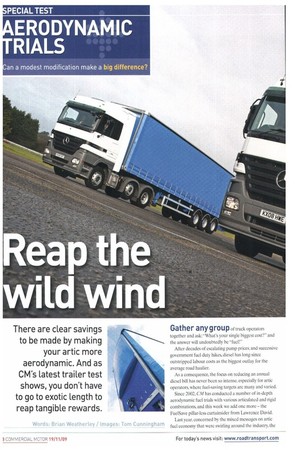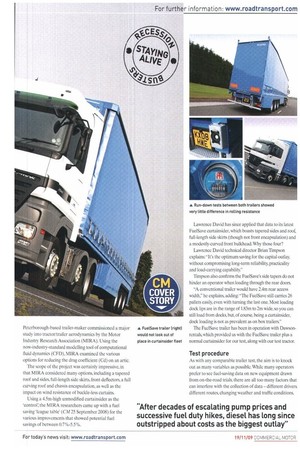Reap the wild wind
Page 38

Page 39

Page 40

If you've noticed an error in this article please click here to report it so we can fix it.
There are clear savings to be made by making your artic more aerodynamic. And as CM's latest trailer test shows, you don't have to go to exotic length to reap tangible rewards.
Words: Brian Weathertey Images: Tom Cunningham Gather any group of truck operators together and ask: -What's your single biggest cost?" and the answer will undoubtedly be "fuel!"
After decades of escalating pump prices, and successive government fuel duty hikes, diesel has long-since outstripped labour costs as the biggest outlay for the average road haulier.
As a consequence, the focus on reducing an annual diesel bill has never been so intense, especially for artic operators, where fuel-saving targets are many and varied.
Since 2002. CM has conducted a number of in-depth aerodynamic fuel trials with various articulated and rigid combinations, and this week we add one more — the FuelSave pillar-less curtainsider from Lawrence David.
Last year, concerned by the mixed messages on artic fuel economy that were swirling around the industry, the Peterborough-based trailer-maker commissioned a major study into tractor/trailer aerodynamics by the Motor Industry Research Association (MIRA). Using the now-industry-standard modelling tool of computational fluid dynamics (CFD), MIRA examined the various options for reducing the drag coefficient (Cd) on an artic.
The scope of the project was certainly impressive, in that MIRA considered many options, including a tapered roof and sides, full-length side skirts, front deflectors, a full curving roof and chassis encapsulation, as well as the impact on wind resistance of buckle-less curtains.
Using a 4.5m-high unmodified curtainsider as the 'control', the MIRA researchers came up with a fuel saving 'league table' (CM 25 September 2008) for the various improvements that showed potential fuel savings of between 0.7%-5.5%. Lawrence David has since applied that data to its latest FuelSave curtainsider, which boasts tapered sides and roof, full-length side skirts (though not front encapsulation) and a modestly-curved front bulkhead. Why those four?
Lawrence David technical director Brian Timpson explains: "It's the optimum saving for the capital outlay, without compromising long-term reliability, practicality and load-carrying capability."
Timpson also confirms the FuelSave's side tapers do not hinder an operator when loading through the rear doors.
"A conventional trailer would have 2.4m rear access width," he explains, adding: "The FuelSave still carries 26 pallets easily, even with turning the last one. Most loading dock lips are in the range of l.83rn to 2m wide, so you can still load from docks, but, of course, being a curtainsider, dock loading is not as prevalent as on box trailers."
A FuelSave trailer (right) The FuelSave trailer has been in operation with Dawson would not look out of rentals, which provided us with the FuelSave trailer plus a place in curtainsider fleet normal curtainsider for our test, along with our test tractor.
Test procedure
As with any comparable trailer test, the aim is to knock out as many variables as possible. While many operators prefer to see fuel-saving data on new equipment drawn from on-the-road trials, there are all too many factors that can interfere with the collection of data — different drivers, different routes, changing weather and traffic conditions, Indeed, for these 'real-life' factors to be mitigated, such trials should ideally he conducted over an extended period, ideally during both winter and summer months. And, naturally, the tests also require scrupulous monitoring of mileage and fuel consumption — fine for some larger fleets, but for the average operator it's a major commitment of time and effort that few can spare.
The alternative is to do what CM does — conduct trials on a test track using the same tractor for both trailers, the same driver, and within the same eight-hour day to keep all the variables to a minimum.
All of CM's aero tests also follow a pattern of warm-up laps, followed by a set number of timed laps of the MIRA high-speed circuit, on cruise control, at 40mph. 50mph and 56mph (64km./11/80km/h/85km/h) using an in-cab flow meter, as well as final tank-top-to-tank-top readings, to monitor intermediate fuel consumption, filling up at the same position on the MIRA diesel pump after each run.
Moreover, such back-to-back testing can be conducted without needing to load the vehicle — we're mainly interested in the actual percentage improvement (or otherwise) in mpg/fuel economy.
One obvious drawback in using two separate trailers is that the frictional drag of their running gear and tyres may vary. Therefore, to see what effect this was having on our two Lawrence David curtainsiders, we also conducted a `coast-down' trial.
On completing the final lap at 56mph (85km/h), we knocked off the cruise control, selected neutral on the Mercedes' auto box and let the tractor and trailer roll to a natural stop. The results were certainly interesting, because the final resting spot for each truck, after a kilometre, was less than a trailer length.
Test units
The pillar-less Lawrence David FuelSave curtainsider incorporates a number of streamlining improvements compared with Dawsonrentals' standard curtainsider.
However, it still retains LD's trademark bolted construction, and like our 'control' trailer, it's also 13.6m long. The most obvious modifications are the adoption of a tapered roof and rear sides. The side taper starts some 2m from the rear doors and continues inwards to the rear aperture, which has an access width of 2,100mm.
The roof tapers from 310mm at the rear to 170mm at the front there's also a GRP deflector on the front bulkhead.
A 1.8m-long aerodynamic rear roof 'scoop' with a 230mm drop is fitted, along with full-length side-skirts although the front opening by the landing legs is not enclosed.
Overall, the FuelSave trailer stands 436m tall based on an unladen fifth-wheel height of 1,250mm.The standard (control) curtainsider stands 4.2m tall and has an untapered body.
Both trailers have Mentor drumbraked axles. Our test tractor was a 6x2 Mercedes Actros 2544 with the latest Powershift auto 'box. •
















































































































































